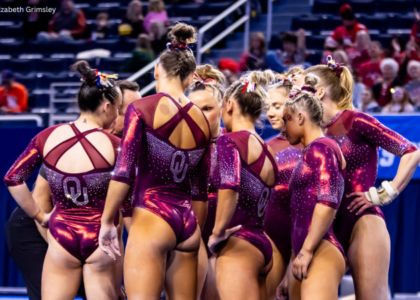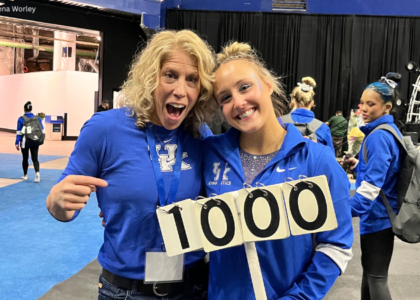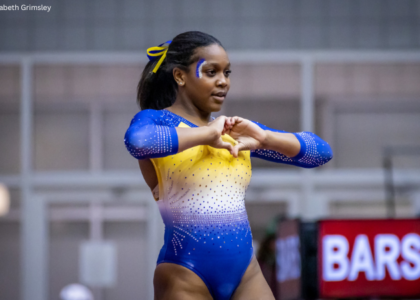Using the scores out of 10.0 already given as the execution scores (E-scores), we broke down the Super Six routine-by-routine and calculated their difficulty scores (D-scores) using the 2013-2016 Code of Points. After adding these two scores together for each gymnast’s final score, we stuck with NCAA rules as far as team score calculation – six up, five count. How will this affect our teams and their scores? Will our powerhouse gymnasts still shine? Will Oklahoma still come out on top? We each wrote down our thoughts before the process began.
Christina: I think that schools with the most elites, or maybe the ones that take the most risks will come out on top. UCLA never shies away from chucking the harder skills, and Alabama and LSU always bring high-level routines, especially on floor. I’d say those three will be toward the top, most likely. As much as I love Oklahoma, they really played it safe last season, which helped them perfect the execution and win under NCAA code. However, that may be their downfall when we look at it from an elite code perspective.
Caroline: The elite code is so nitpicky and weirdly specific with its routine composition requirements that it might be nearly impossible to really predict what’s going to happen. Like Elizabeth, I think difficulty will play a big part — teams with lots of skills that are worth more in elite than in NCAA (since NCAA elements are capped at an E value) will definitely do better. Florida, Georgia and LSU have a lot of these on bars, UCLA has some on beam, and Alabama and LSU should both thrive on floor. Vault will be a really strange animal, since every team competes the same vault, a Yurchenko full, in at least half of their lineup. It may come down to those few extra tenths from a 1.5 as to who wins. I think the team with the most former elites competing may have the edge, which I think is either Alabama or LSU.
For anyone who would like to watch along with our breakdown, here is a link to the full meet on YouTube, courtesy of your friendly neighborhood NastiaFan!
Rotation 1
UB: Georgia – 69.75
BB: Florida – 69.7125
FX: UCLA – 69.775
In this first rotation, the massive gap between vault and the other three events is already evident. This is largely due to CR, or composition requirements, on the other three events that are so incredibly specific and picky in the elite code. The NCAA code has CR as well, but they are far more relaxed and easy to satisfy. Vault, however, doesn’t have any CR to satisfy; vaults are simply assigned a D-score. Thus, Oklahoma ends up massively ahead after the first rotation despite the fact that they only have two vaults valued at a 10.0 in NCAA code.
What’s interesting to note is that only one gymnast in the whole first rotation satisfies all the CR on any event. Angi Cipra (UCLA) had just the right combination of elements to satisfy all five CR on floor: a traveling dance passage (only leaps and hops count, because jumps do not travel), tumbling both forward and backward, a salto with at least a 360-degree twist, a salto with two rotations, and a D-value dismount. That just goes to show how specific the elite code can be, and since NCAA routines aren’t designed with that in mind, most gymnasts will have a little trouble meeting all the requirements.
What’s also revealing is the distribution of difficulty. The only E+ skills in this entire rotation belong to Georgia and UCLA. UCLA has an F skill in Sadiqua Bynum’s double layout, but this difficulty is countered by the fact that she has two double tucks in her routine. An element can only be counted once toward a gymnast’s D-score, so she has to count another A skill, instead of the D-valued double tuck. That’s a three-tenth loss, which basically negates the edge her double layout gives her. On the Georgia front, Brandie Jay and Brittany Rogers actually both have two E skills apiece to boost their D-scores. Both have E-level releases, a Shushunova and a Ricna, respectively, and Jay dismounts with a full-twisting double layout while Rogers transitions with a Van Leeuwen. That’s four extra tenths of difficulty over what a typical NCAA routine would have in it. That actually helped give Georgia what will turn out to be the second-highest bar total of the meet.
Rotation 2
UB: LSU – 68.925
BB: Georgia – 70.375
FX: Alabama – 71.6125
Again, in this rotation, we see the massive gap between vault and the other three, but Alabama really does its best to close it, posting what ends up as the highest non-vault event score in the whole meet. On floor, every single routine from the Tide features either an E or an F pass — they have three double arabians and three double layouts. In addition, four of the six meet the dance passage CR, the one particular requirement that proves to be problematic for almost every other team. Alabama is the only team with more than two gymnasts that satisfy that particular requirement. Each CR is worth half a point, so the difference between two and four gymnasts meeting that CR is a full point — that’s huge!
Some other interesting things of note in this rotation — UCLA vault turns out the lowest vault score of the bunch. This is for a few reasons. Firstly, the E-scores were low. UCLA’s vault score in actual competition was pretty low, their highest score was a 9.85 and they had to count a 9.775. Secondly, though under NCAA rules the Yurchenko “arabian” was still a 10.0 start value last season, it isn’t worth much under elite rules. Not treated any differently from a regular Yurchenko layout half, its D-score is a 4.7, three full tenths less than a standard Yurchenko full. If this were an elite meet, Bynum likely wouldn’t have even made the lineup — even a less-well-executed full would’ve likely been worth more.
Georgia also recorded what becomes the highest beam total of the competition. This is largely due to its ability to fulfill CR, as the only requirement anyone missed out on was the one for a D dismount. Ashlyn Broussard and Rachel Schick lost out on that CR completely, but Jay, Rogers, Vivi Babalis and Mary Beth Box all got partial credit for their C-level dismounts. Couple that with the nine D skills between the five counting routines and another tenth bonus for Schick connecting a D acro element to an A dance skill, and the Gymdogs were in surprisingly great shape on beam. After all their struggles last season on the event, it’s ironic to find them averaging a 14.075 in total score, which is higher than Olympic alternate MyKayla Skinner’s 2016 average on beam.
Rotation 3
UB: Oklahoma – 70.85
BB: LSU – 70.3
FX: Florida – 70.3625
Alabama gains a lot of ground here on vault, thanks to its three Yurchenko 1.5s, and no thanks to its other 10.0 start vaults. Katie Bailey’s Y-arabian went from a solid score to a disappointing one since it’s only worth a 4.7, and Jenna Bresette’s Omelianchik (Yurchenko half-on front pike) is only worth a 4.8, making it less valuable than a decent FTY, even if she had put it to her feet. Somebody like Kiana Winston or even Abby Armbrecht would likely have replaced them in the lineup if NCAA was scored under the elite code.
Another big story in this rotation is Oklahoma on bars. They were the only team to score 70+ on bars and recorded the highest bar total of the competition, largely thanks to McKenzie Wofford and Chayse Capps. Wofford not only met all composition requirements, but also became one of only five gymnasts in the competition to count only skills valued at a B or higher. The top eight skills (including dismount) count toward the overall D-score of a routine, and because NCAA routines are so short, it’s rare to find a routine that has enough elements with enough difficulty to keep them from counting any A skills. As a former elite anchoring her best event, it’s unsurprising that Wofford is on that short list. Capps also did quite well for herself, racking up a 4.5 D-score. To put that in context, Dipa Karmakar (IND) competed a bar routine with a 4.5 D-score at the Rio Test Event and qualified to the Olympics.
This midway point of the competition is obviously where things started to shift a little bit, because there was a third really big story here: LSU on beam. Sydney Ewing, with her back handspring to two-foot layout series, shows us the first E element on beam of the competition, worth an extra tenth of bonus for connection value (CV) and giving her an extra two tenths over the typical NCAA acro series of a back handspring to layout-stepout, a B+C combination. Sarah Finnegan is also a star on this event, not just due to her great execution but her difficulty. Thanks to her wolf turn, she’s the second of those five gymnasts who count all skills over B-value in her D-score. She also has three D skills in her routine, which ratchets up her D-score pretty nicely. Despite the fact that she gets no credit for her dismount at all, she still receives the second-highest score on the squad.
Also worth mentioning is the craziness of Florida floor. Inconsistency abounds as the scores range from 12.8 for Grace McLaughlin, featuring the lowest D-score of the entire competition, a 3.0, to a 14.525 for Kennedy Baker. Nobody meets all CR, though some get close, and two gymnasts, including Bridget Sloan, can only count seven elements due to a rule that says a maximum of 5 acro elements and a minimum of 3 dance elements must compose the D-score. And Bridgey Caquatto, under elite scoring, would not have won Florida the SEC Championship with that routine structured the way it was. However, Baker did give the team an extra difficulty boost with her piked double arabian, valued at an F. Personally, if I were judging, and she said she were going for a laid-out double arabian, I would’ve given her credit for it. In the CoP, it actually outlines angles for knees and hips to distinguish tucks from pikes and pikes from layouts, and after watching it six or seven times, I think her hip angle definitely qualifies her for a layout. Unfortunately, one stellar score doesn’t make a great rotation.
So to give you some perspective here at the halfway mark, where each school has done two events, here’s where we stand.
Rotation 4
UB: UCLA – 68.4875
BB: Oklahoma – 69.3
FX: Georgia – 70.1375
One of the biggest things here is UCLA’s bars. Unfortunately, multiple routines from the Bruins fall into the NCAA trap of using high-level transitions to meet composition requirements instead of just doing a single-bar release. Both Francis and Lee do so, which means that instead of Lee saving the bar rotation like she did at Pac-12 Championships, she earns the lowest D-score of anyone on bars despite her E-level transitions. In an odd turn of events, Sophina DeJesus is the only gymnast this rotation to complete all CR and comes just two tenths shy of Wofford’s record-high D-score.
Oklahoma’s beam turned out to be pretty average as far as difficulty, with Capps as its bright spot as expected. She not only counts all elements above B-level, making her the third gymnast to do so, but she also has the longest routine of anyone in the competition. Longest, in this context, means having the largest number of countable elements toward a D-score. This means different elements with an assigned skill value because elements cannot be repeated to count toward the D-score. Capps ends up with 14 different elements in her beam routine, easily the longest of any routine in the competition. However, this did not give her highest D-score on Oklahoma’s beam team. Nicole Lehrmann and Stefani Catour tie for that honor, and this is largely thanks to their dismounts. Capps’s gainer full is only a B, so she gets no credit for the dismount CR, but Lehrmann and Catour both have C dismounts, so they get partial credit — 0.3 instead of the full 0.5.
More items of interest in this rotation include the sheer lack of difficulty in Florida’s vault, as it played it safe and only had two Y1.5s in its lineup. And Alicia Boren sat hers, so it was the dropped score anyway. Comparatively, it isn’t the worst vault total of the night, but it’s close. With Georgia on floor, every gymnast except Rogers missed the dance passage CR, continuing the trend from earlier rotations. Rogers becomes the seventh gymnast to meet all CR in her routine, and thanks to her difficult tumbling and dance elements, she actually ties with Kennedy Baker for the third-highest floor score of the competition.
Rotation 5
UB: Alabama – 68.7875
BB: UCLA – 70.6
FX: LSU – 71.3625
Rotation 5 sees things really start to turn around for LSU. Its floor total is monstrous, though not the highest in the competition. Every gymnast except Ashleigh Gnat misses the dance passage CR, and three of the six routines can only count seven elements thanks to the five acro/three dance rule mentioned earlier. But despite all this, the entire lineup came up with D-scores 4.0 or higher, and the team only had to count total scores 14.0 or higher. Gnat, since she met all composition requirements and has some very difficult tumbling, comes up with the highest non-vault D-score of the competition, a 5.0, and posts the highest non-vault score of the night, a 14.925. Also worth mentioning is Randii Wyrick, as she became gymnast number four to count all scores valued B or higher.
UCLA’s final event, beam, was its strongest outing (excluding vault because of the inherent score inflation). Both Nicki Shapiro and Katelyn Ohashi receive bonus for their triple series, and Ohashi receives yet another extra tenth for her B+E combination thanks to her two-foot layout. This marks the first time in the competition that anyone has received more than one tenth of CV or series bonus (SB) in one routine. In addition, Danusia Francis becomes gymnast number five to count all B-level skills or higher in her D-score. Her transverse aerial is actually an E element, one of only very few we’ve seen on beam. But unfortunately, since she only does a full twist following that, she does not receive CR credit for her dismount. She and Sophina DeJesus tie for the highest score on the squad, a 14.45.
Georgia’s vault score here is the second highest vault total of the competition, thanks to their three stellar Yurchenko 1.5s. Alabama also had three, but they had vaults worth 4.7 and 4.8 in the lineup as well, rather than all 5.0s like Georgia. In the words of Spencer of the Balance Beam Situation, it really does pay to 1.5! It’s also safe to say at this point that bars is consistently the lowest-scoring event of the four, with only one team total breaking 70. Despite the fact that Alabama had three gymnasts only miss one CR, rather than two like most in the competition, and had three E releases and one D+D combination (which gives a tenth in connection value bonus, making one of the two skills worth as much as an E), their score still stayed quite low. Only Mackenzie Brannan scored over a 14.0.
At this point, competition for Georgia and UCLA is done. Their final totals stand at 285.7375 and 283.1875, respectively. Georgia’s total is actually pretty high compared to other teams’ right now — they could even put up a fight for first depending on how LSU and Alabama do in the final rotation.
Rotation 6
UB: Florida – 67.6875
BB: Alabama – 69.85
FX: Oklahoma – 69.1375
And finally, we have our winners. LSU puts the last nail in the coffin here with their high difficulty, particularly from Gnat, who posts both the highest D-score and highest total score of the competition with her Yurchenko double full. They also get a boost from 1.5s from Sydney Ewing and Jessica Savona. Alabama puts up a valiant effort, as Kiana Winston becomes the only gymnast on balance beam to get credit for all CR and Nickie Guerrero earns 0.2 CV for her series, 0.1 in SB and 0.1 for the C+C connection. However, with five of the six gymnasts missing at least one CR, some two, and Winston having to count four A skills in her routine, they couldn’t get out of the hole to pass LSU or Georgia.
Oklahoma, while beautiful on floor, doesn’t have a whole lot of difficulty. In fact, it is the lowest floor total of the competition. Here is honestly where the Sooners lose it all, as they’ve stayed fairly competitive throughout the competition. None of the Sooners meet the dance passage requirement, and only one has an E pass to try to make up any of that lost ground. In addition, Natalie Brown, Keeley Kmieciak and Charity Jones are all only able to count seven elements thanks to that pesky five acro/three dance requirement. If five of the six gymnasts had different dance passages in order to get the CR credit, Oklahoma would have won the competition. Four of the six would’ve given them silver, and three would’ve come in just over Alabama for third.
And this is where things really bottom out for Florida. Baker is the only gymnast to miss one CR in this lineup — everyone else misses at least two, and Bianca Dancose-Giambattisto actually misses three, thanks to her lack of a single-bar release. The only thing that saves her from tying for the lowest D-score in the competition is a 0.1 CV bonus for connecting her D+D transitions. This Florida bar squad is the only rotation in the entire competition not to count at least one score over a 14.0. Thanks to this, coupled with some losses in other places, Florida actually ends up last overall.




